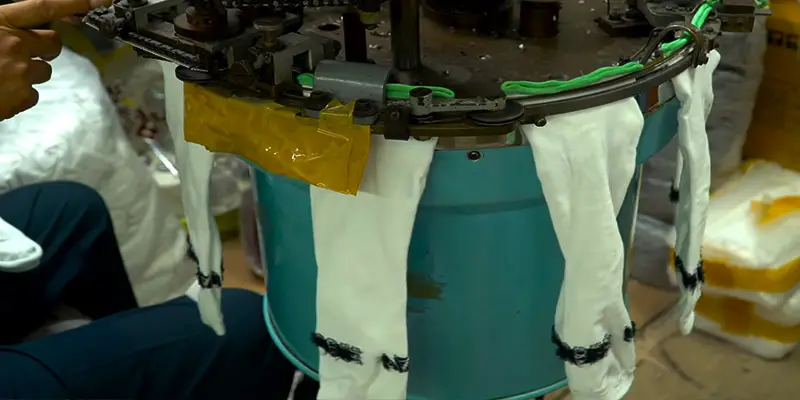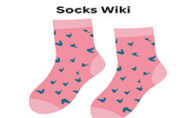Hi, I'm Christopher Bevans, the creator of SocksWiki.com. With a background in fashion design and a passion for innovation, I’m here to share my knowledge on socks from troubleshooting tips to detailed buying guides. I believe the right pair of socks can make all the difference, and through this site, I aim to help you find the perfect fit for every occasion.
Hi, I'm Christopher Bevans, the creator of SocksWiki.com. With a background in fashion design and a passion for innovation, I’m here to share my knowledge on socks from troubleshooting tips to detailed buying guides. I believe the right pair of socks can make all the difference, and through this site, I aim to help you find the perfect fit for every occasion.
Socks are usually made of cotton, wool, polyester, nylon, spandex, or blends of these materials. Each fabric provides specific benefits like comfort, durability, elasticity, or moisture-wicking properties.
From the softness of cotton to the warmth of wool and the durability of nylon, the composition of socks plays a crucial role in their comfort, performance, and suitability for different activities.
Understanding what socks are made out of provides insight into their functionality and helps in choosing the right pair for every occasion.
Now, we are going to know about 16 common materials with which socks are manufacturing, unraveling their properties and explaining their significance in the realm of footwear.

16 Common Materials From What Socks Are Made Out Of:
Socks are essential clothing items designed to provide comfort, warmth, and protection for our feet. They can be made from a wide range of materials, each offering unique benefits.
Here, explore what socks are made out of:
1. Cotton
Cotton is a staple material in the textile industry and a favorite for making socks due to its natural qualities.
Cotton fibers are soft and gentle against the skin, making them comfortable for prolonged wear. The breathability of cotton allows air to circulate, helping to keep feet cool and dry.
Additionally, cotton has excellent moisture-absorbing properties, which means it can soak up sweat and reduce the risk of blisters and fungal infections. However, pure cotton socks can lose shape and wear out quickly.
To overcome these limitations, manufacturers often blend cotton with synthetic fibers like spandex or polyester, which enhance elasticity, durability, and moisture-wicking capabilities.
2. Wool
Wool, especially from sheep, has been used for centuries to create warm and insulating clothing. Wool fibers have a unique crimp, allowing them to trap air and provide excellent insulation, which keeps feet warm in cold conditions.
Wool is also hygroscopic, meaning it can absorb moisture without feeling wet, which helps keep feet dry and comfortable.
Additionally, wool has natural antibacterial properties, which reduce foot odor and the risk of infections.
Merino wool, a high-quality variant, is finer and softer than regular wool, making it less itchy and more suitable for sensitive skin.
Wool socks are often preferred for outdoor activities like hiking and skiing due to their warmth and moisture management.
3. Nylon
Nylon is a synthetic polymer that is highly valued for its strength, elasticity, and abrasion resistance.
Nylon fibers are smooth and durable, which helps socks maintain their shape and resist wear and tear.
The elasticity of nylon allows socks to stretch and fit snugly around the feet, providing support and reducing the likelihood of slipping or bunching.
Nylon also has some moisture-wicking properties, though not as effective as those of natural fibers like wool.
It is often used in blends with other fibers to enhance the durability and fit of socks, making them suitable for everyday use and athletic activities.
4. Acrylic
Acrylic is a versatile synthetic fiber often used as a wool substitute due to its softness and warmth. Acrylic fibers are lightweight, making socks comfortable for extended wear without feeling heavy.
They provide good insulation, keeping feet warm in cooler temperatures. Acrylic is also resilient, maintaining its shape and color even after multiple washes.
However, acrylic does not wick moisture as efficiently as natural fibers, so it is often blended with other materials to improve its moisture management.
Acrylic socks are a cost-effective option for those seeking the warmth and softness of wool without the higher price tag.
5. Polyester
Polyester is a durable synthetic fiber that is widely used in the production of socks due to its resilience and quick-drying properties.
Polyester fibers are strong and resistant to shrinking, stretching, and wrinkling, ensuring that socks maintain their shape and appearance over time.
Polyester is also hydrophobic, meaning it repels water and dries quickly, which helps keep feet dry during physical activities.
This makes polyester socks a popular choice for athletes and active individuals. Additionally, polyester can be engineered to enhance its moisture-wicking abilities, further improving comfort during strenuous activities.
8. Olefins (Polypropylene)
Polypropylene, a type of olefin, is a synthetic fiber known for its superior moisture-wicking capabilities.
It is lightweight and highly durable, making it ideal for high-performance socks. Polypropylene fibers do not absorb water; instead, they transport moisture away from the skin to the outer surface of the fabric, where it can evaporate quickly.
This helps keep feet dry and comfortable, reducing the risk of blisters and discomfort during prolonged wear.
Polypropylene is also resistant to stains, fading, and abrasion, ensuring that socks remain in good condition even after heavy use. These properties make it an excellent choice for athletic and outdoor socks.
7. Silk
Silk is a natural protein fiber known for its smoothness, sheen, and luxurious feel. Silk socks are incredibly soft, providing a high level of comfort and a touch of elegance.
The fibers are lightweight and have excellent moisture-wicking properties, making silk socks suitable for both warm and cool weather.
This allows them to regulate temperature effectively, keeping feet cool in summer and warm in winter.
Additionally, silk is naturally hypoallergenic, which makes it an excellent choice for people with sensitive skin or allergies.
However, silk socks can be more delicate and require special care, such as hand washing or using a gentle cycle with mild detergent to maintain their quality and longevity.
8. Bamboo
Bamboo fibers are derived from the bamboo plant and are known for their exceptional softness, breathability, and eco-friendliness.
Bamboo socks are naturally antibacterial, which helps to reduce odor and keep feet fresh. They are also moisture-wicking, drawing sweat away from the skin to keep feet dry, reducing the risk of blisters and fungal infections.
Bamboo is a highly sustainable resource, as it grows rapidly and requires fewer pesticides and less water compared to traditional crops.
The comfort and versatility of bamboo socks make them suitable for both warm and cool weather. Additionally, bamboo socks are biodegradable, adding to their environmental benefits.
9. Linen
Linen is made from the fibers of the flax plant and is renowned for its strength, durability, and breathability.
Linen socks are cool and comfortable, making them ideal for warm weather. The natural fibers allow air to circulate, which helps keep feet dry and cool.
Linen is highly durable and becomes softer with each wash, providing long-lasting comfort and wear.
It is also moisture-wicking and quick-drying, which helps prevent sweaty and uncomfortable feet.
The durability and breathability of linen make it a practical choice for everyday wear, especially in hot and humid climates.
10. Cashmere
Cashmere is a luxurious fiber obtained from the undercoat of cashmere goats. It is exceptionally soft, lightweight, and warm, making cashmere socks a premium choice for ultimate comfort and warmth.
Cashmere socks provide a high level of insulation while remaining breathable, ensuring that feet stay warm without overheating.
The fibers are gentle on the skin, making them ideal for people with sensitive skin. However, cashmere socks can be more expensive and require delicate care, such as hand washing or dry cleaning, to maintain their softness and prevent damage.
Despite the higher maintenance, the unparalleled comfort and warmth of cashmere make it a worthwhile investment for cold weather wear.
11. Mohair
Mohair is made from the hair of the Angora goat and is valued for its exceptional softness, durability, and luster.
Mohair socks are warm, resilient, and less likely to pill compared to other fibers. They provide excellent insulation, making them ideal for cold weather, while their natural elasticity helps socks retain their shape and fit well over time.
Mohair fibers are also moisture-wicking and breathable, which helps keep feet dry and comfortable.
The combination of durability, warmth, and comfort makes mohair socks a long-lasting and luxurious option for winter wear.
12. Spandex (Lycra)
Spandex, also known by the brand name Lycra, is a synthetic fiber known for its exceptional elasticity. It is often blended with other materials to provide stretch and improve the fit of socks.
Spandex helps socks maintain their shape and ensures a snug fit, preventing them from slipping or bunching. This makes them particularly useful in athletic and compression socks, where a secure fit is crucial.
Spandex also enhances the durability and comfort of socks, making them suitable for both everyday wear and sports activities.
The ability to stretch and return to its original shape makes spandex an essential component in high-performance socks.
13. Rayon
Rayon is a semi-synthetic fiber made from regenerated cellulose. It is soft, smooth, and breathable, making it a comfortable material for socks.
Rayon can mimic the feel of natural fibers like silk and cotton, providing a luxurious touch and a lightweight feel.
It also has good moisture-wicking properties, helping to keep feet dry by drawing moisture away from the skin.
However, rayon is less durable than some other fibers and may require more careful washing to maintain its integrity and softness.
Despite its delicate nature, the comfort and breathability of rayon make it a popular choice for dress and casual socks.
14. Modal
Modal is a type of rayon made from beech tree pulp. It is exceptionally soft, smooth, and breathable, offering a high level of comfort.
Modal socks are also highly absorbent and moisture-wicking, making them suitable for keeping feet dry and comfortable.
Modal is more durable than regular rayon and retains its shape and softness even after multiple washes. This makes modal socks a practical and comfortable choice for everyday wear.
The combination of softness, durability, and moisture management makes modal an excellent material for high-quality socks.
15. Tencel (Lyocell)
Tencel, also known as lyocell, is an eco-friendly fiber made from wood pulp, usually from eucalyptus trees. It is soft, breathable, and moisture-wicking, making it an excellent material for socks.
Tencel fibers are strong and durable, ensuring that socks made from this material last longer and withstand regular wear and washing.
Additionally, Tencel is biodegradable and produced through a sustainable process that uses less water and energy, making it an environmentally friendly choice.
The comfort, durability, and environmental benefits of Tencel make it an attractive option for eco-conscious consumers.
16. Alpaca
Alpaca fiber comes from the fleece of alpacas and is known for its exceptional softness, warmth, and hypoallergenic properties.
Alpaca socks are warm and insulating, making them ideal for cold weather. The fibers are also naturally moisture-wicking and breathable, helping to keep feet dry and comfortable.
Alpaca fiber is durable and resistant to pilling, ensuring that socks maintain their quality over time.
Additionally, alpaca fibers are hypoallergenic, making them suitable for people with sensitive skin or allergies.
The combination of warmth, comfort, and durability makes alpaca socks a luxurious and practical choice for winter wear.
FAQs
What Are Socks Mostly Made Of?
Socks are mostly made of a combination of natural and synthetic fibers such as cotton, wool, nylon, acrylic, polyester, and olefins (like polypropylene).
These materials are often blended to optimize comfort, durability, and performance.
Why Are Socks Not 100% Cotton?
Socks are not typically 100% cotton because pure cotton lacks the elasticity and durability needed for prolonged wear.
Blending cotton with synthetic fibers like spandex or polyester enhances the fit, stretch, and longevity of the socks, while also improving moisture-wicking properties.
What Fabric is Best for Socks?
Wool is excellent for warmth and moisture management, making it great for cold weather.
For athletic activities, synthetic materials like polyester and nylon offer superior moisture-wicking and durability.
What Are Socks Made of Cotton?
Socks made of cotton typically contain a blend of cotton and synthetic fibers.
The cotton provides softness and breathability, while synthetic fibers like spandex or polyester add elasticity, durability, and improved moisture management.
What Are Socks Made of Fabric?
Socks are made from various fabrics, including cotton, wool, bamboo, polyester, nylon, spandex, linen, and silk. These materials are often blended to enhance comfort, durability, stretch, and moisture control.

Hi, I'm Christopher Bevans, the creator of SocksWiki.com. With a background in fashion design and a passion for innovation, I’m here to share my knowledge on socks from troubleshooting tips to detailed buying guides. I believe the right pair of socks can make all the difference, and through this site, I aim to help you find the perfect fit for every occasion.
- Latest Posts by Christopher Bevans
-
What Socks to Wear With Cowboy Boots?
- -
Grip Socks vs Regular Socks: Which One Should Wear?
- -
Are White or Black Socks Better: Comfort, Style, and Function
- All Posts


